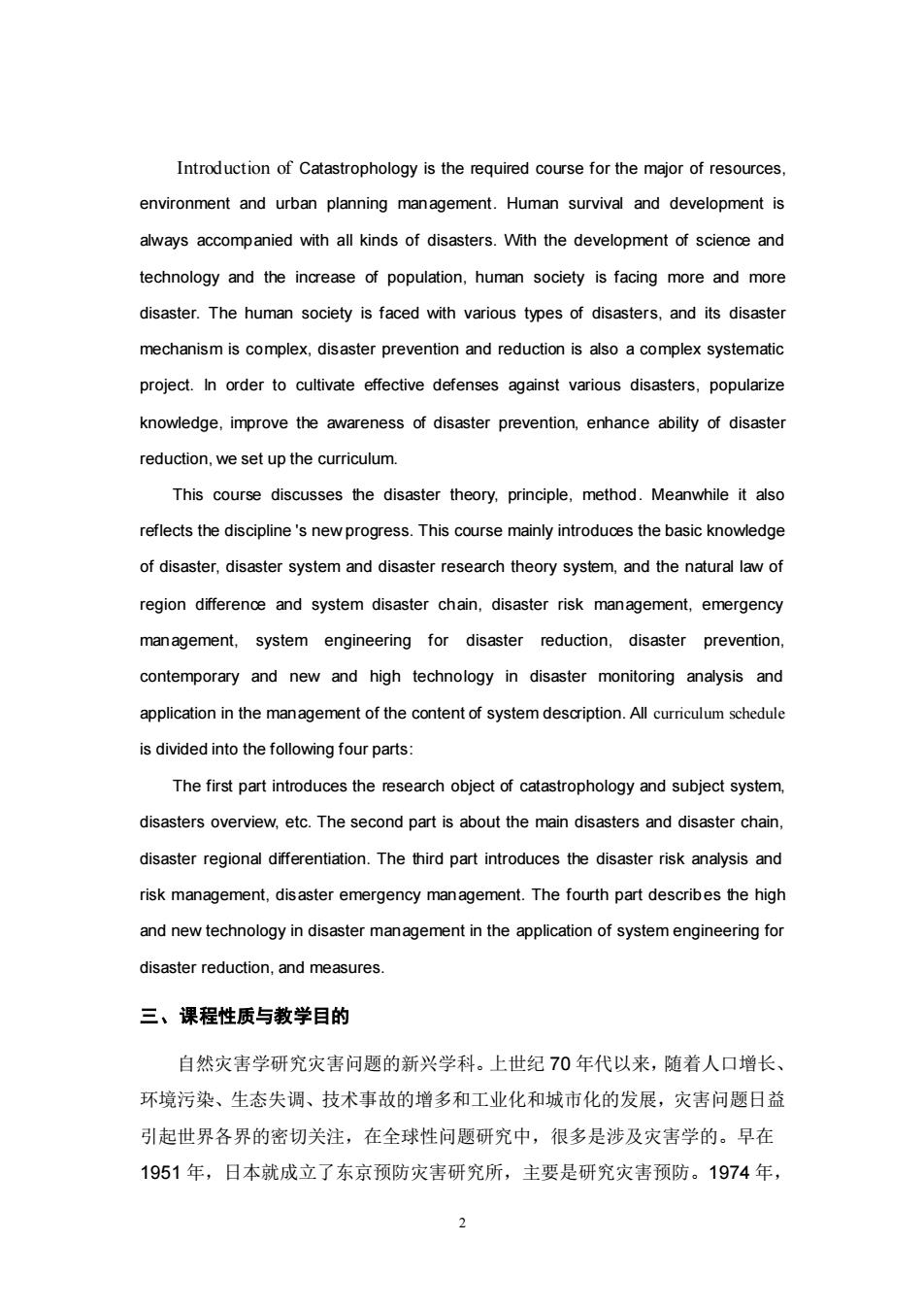正在加载图片...

Introduction of Catastrophology is the required course for the major of resources. environment and urban planning management.Human survival and development is always accompanied with all kinds of disasters.With the development of science and technology and the increase of population,human society is facing more and more disaster.The human society is faced with various types of disasters,and its disaster mechanism is complex.disaster prevention and reduction is also a complex systematic project.In order to cultivate effective defenses against various disasters,popularize knowledge,improve the awareness of disaster prevention,enhance ability of disaster reduction.we set up the curriculum. This course discusses the disaster theory.principle,method.Meanwhile it also reflects the discipline's newprogress.This course mainly introduces the basic knowledge of disaster,disaster system and disaster research theory system,and the natural law of region difference and system disaster chain,disaster risk management,emergency management.system engineering for disaster reduction.disaster prevention. contemporary and new and high technology in disaster monitoring analysis and application in the management of the content of system description.All schedule is divided into the following four parts The first part introduces the research object of catastrophology and subject system, disasters overview,etc.The second part is about the main disasters and disaster chain, disaster regional differentiation.The third part introduces the disaster risk analysis and risk management,disaster emergency management.The fourth part describes the high and new technology in disaster management in the application of system engineering for disaster reduction,and measures. 三、课程性质与教学目的 自然灾害学研究灾害问题的新兴学科。上世纪70年代以来,随着人口增长、 环境污染、生态失调、技术事故的增多和工业化和城市化的发展,灾害问题日益 引起世界各界的密切关注,在全球性问题研究中,很多是涉及灾害学的。早在 1951年,日本就成立了东京预防灾害研究所,主要是研究灾害预防。1974年,2 Introduction of Catastrophology is the required course for the major of resources, environment and urban planning management. Human survival and development is always accompanied with all kinds of disasters. With the development of science and technology and the increase of population, human society is facing more and more disaster. The human society is faced with various types of disasters, and its disaster mechanism is complex, disaster prevention and reduction is also a complex systematic project. In order to cultivate effective defenses against various disasters, popularize knowledge, improve the awareness of disaster prevention, enhance ability of disaster reduction, we set up the curriculum. This course discusses the disaster theory, principle, method. Meanwhile it also reflects the discipline 's new progress. This course mainly introduces the basic knowledge of disaster, disaster system and disaster research theory system, and the natural law of region difference and system disaster chain, disaster risk management, emergency management, system engineering for disaster reduction, disaster prevention, contemporary and new and high technology in disaster monitoring analysis and application in the management of the content of system description. All curriculum schedule is divided into the following four parts: The first part introduces the research object of catastrophology and subject system, disasters overview, etc. The second part is about the main disasters and disaster chain, disaster regional differentiation. The third part introduces the disaster risk analysis and risk management, disaster emergency management. The fourth part describes the high and new technology in disaster management in the application of system engineering for disaster reduction, and measures. 三、课程性质与教学目的 自然灾害学研究灾害问题的新兴学科。上世纪 70 年代以来,随着人口增长、 环境污染、生态失调、技术事故的增多和工业化和城市化的发展,灾害问题日益 引起世界各界的密切关注,在全球性问题研究中,很多是涉及灾害学的。早在 1951 年,日本就成立了东京预防灾害研究所,主要是研究灾害预防。1974 年